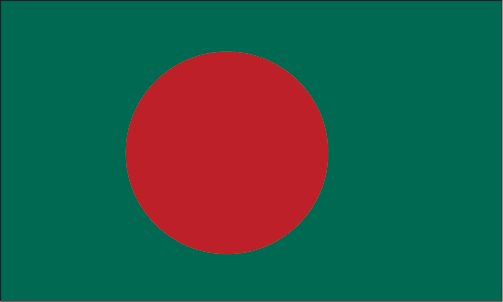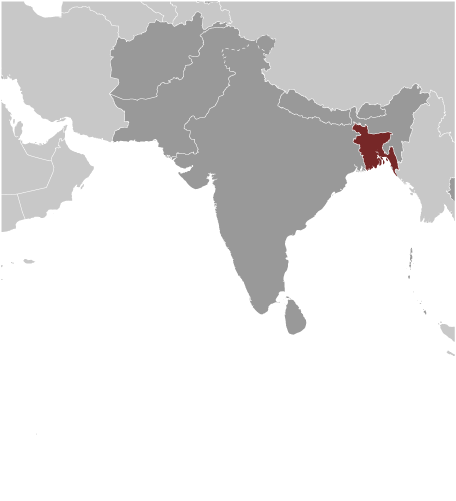Bangladesh

Opportunity For All works with Room to Read in Bangladesh. We built our first school their in 2013.
Located between India and Myanmar, Bangladesh became a nation in 1971 after a bloody war of independence that separated it from Pakistan. The fledgling country has seen its share of natural disasters and famines, as well as political turmoil and military coups, but since 1991, when a system of parliamentary democracy was established, it has experienced relative stability and economic progress. Home to 140 million residents, Bangladesh is the most densely-populated country in the world and also one of its poorest and least developed. Although per capita GDP has more than doubled since 1975, the country remains 147th out of 179 countries on the Human Development Index.
Poverty in Bangladesh is in decline, having fallen 20 percent since 1990. Most of this economic growth has been fueled by industrialization in Dhaka and other urban centers, where foreign investors can capitalize on the country’s large, hardworking labor pool and low wages.
The Government of Bangladesh has made primary education a high priority since passing the Primary Education Compulsory Act in 1990, which made education through 5th grade mandatory and free for all students. Nonetheless, Bangladesh still faces many educational challenges.
It has one of the largest primary education systems in the world, with an estimated 18 million primary school aged children (ages 6 to 10 years). Because of this, the student to teacher ratio in government primary school is 59:1, which is challenging for students and teachers alike, and school hours are limited to four hours per day. Access to resources can also be a problem, with no formal library system in the country’s schools. As a result of these and other factors, school completion rates and academic achievement in Bangladesh remain low, with 56% of all students dropping out before secondary school.
Located between India and Myanmar, Bangladesh became a nation in 1971 after a bloody war of independence that separated it from Pakistan. The fledgling country has seen its share of natural disasters and famines, as well as political turmoil and military coups, but since 1991, when a system of parliamentary democracy was established, it has experienced relative stability and economic progress. Home to 140 million residents, Bangladesh is the most densely-populated country in the world and also one of its poorest and least developed. Although per capita GDP has more than doubled since 1975, the country remains 147th out of 179 countries on the Human Development Index.
Poverty in Bangladesh is in decline, having fallen 20 percent since 1990. Most of this economic growth has been fueled by industrialization in Dhaka and other urban centers, where foreign investors can capitalize on the country’s large, hardworking labor pool and low wages.
The Government of Bangladesh has made primary education a high priority since passing the Primary Education Compulsory Act in 1990, which made education through 5th grade mandatory and free for all students. Nonetheless, Bangladesh still faces many educational challenges.
It has one of the largest primary education systems in the world, with an estimated 18 million primary school aged children (ages 6 to 10 years). Because of this, the student to teacher ratio in government primary school is 59:1, which is challenging for students and teachers alike, and school hours are limited to four hours per day. Access to resources can also be a problem, with no formal library system in the country’s schools. As a result of these and other factors, school completion rates and academic achievement in Bangladesh remain low, with 56% of all students dropping out before secondary school.

As in many other developing countries, educational access is particularly poor in rural areas, where schools are few and far between and children are expected to work to contribute to family income. This divide is reflected in the stark contrast between literacy rates in rural and urban areas—a nearly 30% difference.
For girls in Bangladesh, the barriers to education are even greater than those of their male peers, with cultural norms and early marriage often preventing young women from fulfilling their academic potential.
Room to Read established operations in Bangladesh in 2008, and started their school building program in 2103. Room to Read’s work has thus far focused in rural areas—particularly the sandbar islands of the Sirajganj District and the low-lying terrain of the Brahamanbaria district.
For general information about Bangladesh, please look at the following:
• Wikipedia, Bangladesh
• U.S. Department of State, Bangladesh
• UNICEF, Bangladesh
• CIA Factbook, Bangladesh
For girls in Bangladesh, the barriers to education are even greater than those of their male peers, with cultural norms and early marriage often preventing young women from fulfilling their academic potential.
Room to Read established operations in Bangladesh in 2008, and started their school building program in 2103. Room to Read’s work has thus far focused in rural areas—particularly the sandbar islands of the Sirajganj District and the low-lying terrain of the Brahamanbaria district.
For general information about Bangladesh, please look at the following:
• Wikipedia, Bangladesh
• U.S. Department of State, Bangladesh
• UNICEF, Bangladesh
• CIA Factbook, Bangladesh
